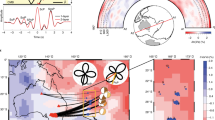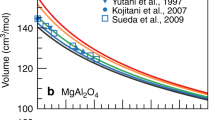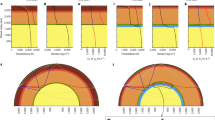Abstract
Ultralow-velocity zones (ULVZs) are regions of the Earth's core–mantle boundary about 1–10 kilometres thick exhibiting seismic velocities that are lower than radial-Earth reference models by about 10–20 per cent for compressional waves and 10–30 per cent for shear waves. It is also thought that such regions have an increased density of about 0–20 per cent (ref. 1). A number of origins for ULVZs have been proposed, such as ponding of dense silicate melt2, core–mantle reaction zones3 or underside sedimentation from the core4. Here we suggest that ULVZs might instead be relics of banded iron formations subducted to the core–mantle boundary between 2.8 and 1.8 billion years ago. Consisting mainly of interbedded iron oxides and silica, such banded iron formations were deposited in the world's oceans during the late Archaean and early Proterozoic eras. We argue that these layers, as part of the ocean floor, would be recycled into the Earth's interior by subduction5, sink to the bottom of the mantle and may explain all of the observed features of ULVZs.
This is a preview of subscription content, access via your institution
Access options
Subscribe to this journal
Receive 51 print issues and online access
$199.00 per year
only $3.90 per issue
Buy this article
- Purchase on Springer Link
- Instant access to full article PDF
Prices may be subject to local taxes which are calculated during checkout


Similar content being viewed by others
References
Garnero, E. J., Revenaugh, J., Williams, Q., Lay, T. & Kellog, L. H. in The Core-Mantle Boundary Region (eds Gurnis, M., Wysession, M. E., Knittle, E. & Buffet, B. A.) 319–334 (American Geophysical Union, Washington DC, 1998)
Williams, Q. & Garnero, E. J. Seismic evidence for partial melt at the base of the mantle. Science 273, 1528–1530 (1996)
Knittle, E. & Jeanloz, R. Simulating the core-mantle boundary: an experimental study of high-pressure reactions between silicates and liquid iron. Geophys. Res. Lett. 16, 609–612 (1989)
Buffett, B. A., Garnero, E. J. & Jeanloz, R. Sediments at the top of Earth's core. Science 290, 1338–1342 (2000)
Polat, A., Hofman, A. W. & Rosing, M. T. Boninite-like volcanic rocks in the 3.7–3.8 Ga Isua greenstone belt, West Greenland: geochemical evidence for intra-oceanic subduction zone processes in the early Earth. Chem. Geol. 184, 231–254 (2002)
Cloud, P. Paleoecological significance of the banded iron formation. Econ. Geol. 68, 1135–1143 (1973)
James, H. L. in Iron Formation: Facts and Problems (eds Trendall, A. F. & Morris, R. C.) 472–473 (Elsevier, Amsterdam, 1983)
Castro, L. O. Genesis of banded iron-formations. Econ. Geol. 89, 1384–1397 (1994)
Kusky, T. M., Li, J.-H. & Tucker, R. D. The Archean Dongandzi Ophiolite Complex, North China Craton: 2.505-billion-year-old oceanic crust and mantle. Science 292, 1142–1146 (2001)
Gnaneshwar Rao, T. & Naqvi, S. M. Geochemistry, depositional environment and tectonic setting of the BIF's of the late Archaean Chitradurga Schist Belt, India. Chem. Geol. 121, 217–243 (1995)
Taira, A., Pickering, K. T., Windley, B. F. & Soh, W. Accretion of Japanese island arcs and implications for the origin of Archean greenstone belts. Tectonics 11, 1224–1244 (1992)
Kárason, H. & Van der Hilst, R. D. in The History and Dynamics of Global Plate Motion (eds Richards, M. R., Gordon, R. & Van der Hilst, R. D.) 277–288 (American Geophysical Union, Washington DC, 2000)
Mao, H. K., Takahashi, T., Basset, W. A., Kinsland, G. L. & Merrill, L. Isothermal compression of magnetite up to 320 kbar and pressure induced phase transformation. J. Geophys. Res. 79, 1165–1170 (1974)
Ross, N. L., Shu, J. F., Hazen, R. M. & Gasparik, T. High-pressure crystal chemistry of stishovite. Am. Mineral. 75, 739–747 (1990)
Will, G., Hinze, E. & Nuding, W. The compressibility of FeO measured by energy dispersive X-ray diffraction in a diamond anvil squeezer up to 200 kbar. Phys. Chem. Miner. 6, 157–167 (1980)
Fei, Y. W. & Mao, H. K. In-situ determination of the NiAs phase of FeO at high-pressure and temperature. Science 266, 1678–1680 (1994)
Dziewonski, A. M. & Anderson, D. L. Preliminary reference Earth model. Phys. Earth Planet. Inter. 25, 297–356 (1981)
Hauri, E. H. & Hart, S. R. Re-Os isotope systematics of HIMU and EMII oceanic island basalts from the south-pacific ocean. Earth Planet. Sci. Lett. 114, 353–371 (1993)
Knittle, E. & Jeanloz, R. The high pressure phase diagram of Fe0.94O: a possible constituent of the Earth's core. J. Geophys. Res. 96, 16169–16180 (1991)
Rubie, D. C., Gessmann, C. K. & Frost, D. J. Partitioning of oxygen during core formation on the Earth and Mars. Nature 429, 58–61 (2004)
Poirier, J. P., Malavergne, V. & Le Mouël, J. L. in The Core-Mantle Boundary Region (eds Gurnis, M., Wysession, M. E., Knittle, E. & Buffet, B. A) 131–138 (American Geophysical Union, Washington DC, 1998)
Kondo, T., Ohtani, E., Hirao, N., Yagi, T. & Kikegawa, T. Phase transitions of (Mg,Fe)O at megabar pressures. Phys. Earth Planet. Inter. 143–144, 201–213 (2004)
Jacobsen, S. D., Spetzler, H., Reichmann, H. J. & Smyth, J. R. Shear waves in the diamond-anvil cell reveal pressure-induced instability in (Mg,Fe)O. Proc. Natl Acad. Sci. USA 101, 5867–5871 (2004)
Persch, S. E. & Vidale, J. E. Reflection properties of the core-mantle boundary from global stacks of PcP and ScP . J. Geophys. Res. 109, doi:10.1029/2003JB002768 (2004)
Knittle, E. & Jeanloz, R. High-pressure metallization of FeO and implications for the Earth's core. Geophys. Res. Lett. 13, 1541–1544 (1986)
Buffet, B. A. Constraints on magnetic energy and mantle conductivity from the forced nutations of the Earth. J. Geophys. Res. 97, 19581–19597 (1992)
Stix, M. & Roberts, P. H. Time-dependent electromagnetic core-mantle coupling. Phys. Earth Planet. Inter. 36, 49–60 (1984)
Holme, R. Electromagnetic core-mantle coupling - I. Explaining decadal changes in the length of day. Geophys. J. Int. 132, 167–180 (1998)
Acknowledgements
We thank P. Bown and M. Kendall for discussions. This work was performed under the auspices of the Deep Earth System Consortium. D.D. was supported by a Royal Society University Research Fellowship.
Author information
Authors and Affiliations
Corresponding author
Ethics declarations
Competing interests
The authors declare that they have no competing financial interests.
Supplementary information
Supplementary Figure S1
Figure showing settling velocity with slab angle for the mixed diapir/conduit flow model. (PDF 12 kb)
Supplementary Figure Legend
This file contains the figure caption for Supplementary Figure S1, describing the diapir and conduit flow models. (DOC 22 kb)
Rights and permissions
About this article
Cite this article
Dobson, D., Brodholt, J. Subducted banded iron formations as a source of ultralow-velocity zones at the core–mantle boundary. Nature 434, 371–374 (2005). https://doi.org/10.1038/nature03430
Received:
Accepted:
Issue Date:
DOI: https://doi.org/10.1038/nature03430
This article is cited by
-
Detections of ultralow velocity zones in high-velocity lowermost mantle linked to subducted slabs
Nature Geoscience (2024)
-
Earth’s mantle composition revealed by mantle plumes
Nature Reviews Earth & Environment (2023)
-
Links between large igneous province volcanism and subducted iron formations
Nature Geoscience (2023)
-
Core origin of seismic velocity anomalies at Earth’s core–mantle boundary
Nature (2023)
-
Internal structure of ultralow-velocity zones consistent with origin from a basal magma ocean
Nature Geoscience (2022)
Comments
By submitting a comment you agree to abide by our Terms and Community Guidelines. If you find something abusive or that does not comply with our terms or guidelines please flag it as inappropriate.



